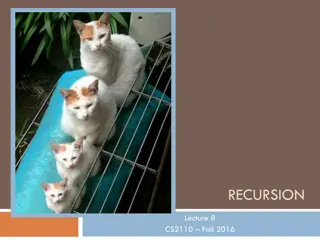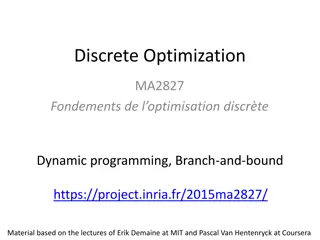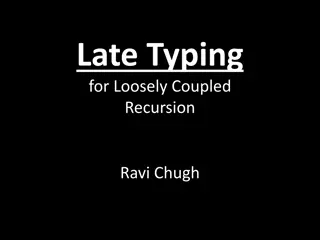Understanding Recursion in Programming
Explanation of recursion in programming, including objectives, examples, and step-by-step breakdown. Learn how to design functions using recursion to solve problems effectively. Dive into the concept of recursive functions with a practical example of writing digits of an integer vertically. Explore pseudocode and techniques for manipulating integers in recursive functions.
Download Presentation

Please find below an Image/Link to download the presentation.
The content on the website is provided AS IS for your information and personal use only. It may not be sold, licensed, or shared on other websites without obtaining consent from the author. Download presentation by click this link. If you encounter any issues during the download, it is possible that the publisher has removed the file from their server.
E N D
Presentation Transcript
Objectives At the conclusion of this lesson, students should be able to Explain what recursion is Design and write functions that use recursion Think recursively
Example Write a function that takes an integer value, and writes the individual digits of the integer down the screen in a vertical line. for example, writeVertical (123); would produce 1 2 3
The function can be broken down into two tasks. Simple case: if n < 10, then just write the number n to the screen. After all, the number is just one digit long and there is nothing else to do. Recursive case: if n >= 10, there are two things to do: 1. Output all digits except the last one 2. Output the last one
So, given the integer 1234 1 2 3 4 we note that 1234 is bigger than 10, so the first step is to call writeVertical(123) and then output 4. This outputs all of the digits but the last one This outputs the last one then, given the integer 123 we note that 123 is bigger than 10, so the first step is to call writeVertical(12) and then output 3. then, given the integer 12 we note that 12 is bigger than 10, so the first step is to call writeVertical(1) and then output 2. finally, given the integer 1 we note that 1 is less than 10, so we output it.
We could describe the writeVertical algorithm using the following pseudocode: if (n < 10) output n; else // since n is two or more digits long { writeVertical (n with the last digit removed); ouput the last digit; }
We can remove the last digit of a positive integer n, by dividing the number by 10. For example if n = 34786, n / 10 = 3478 then because of integer division!
We can calculate the last digit of a positive integer n, by dividing the number by 10 and taking the remainder. For example if n = 34786, n % 10 = 6 then
So, the writeVertical function looks like void writeVertical( int n) { if (n < 10) cout << n << endl; else { writeVertical (n/10); cout << (n % 10) << endl; } }
General Outline of a Recursive Function It must have one or more cases where the algorithm accomplishes its task by calling itself with a subset of the original task to be done. It must have at least one case where the algorithm accomplishes its task without having to call itself. This is called the stopping or base case. Without this base case, the algorithm will run forever . This is called infinite recursion.
Stack Overflow Recall that function calls make use of the runtime stack to pass parameters and the address to return to when the function has completed its work. When a recursive function has no stopping case, the function calls itself over and over again until the stack fills up. This results in a stack overflow error.
Recursion vs. Iteration In many cases, a task can be done by using iteration (loops) instead of recursion. In general, recursive functions are simpler than iterative ones. However, recursive functions usually run slower and take more storage than their iterative counterparts.
Iterative Version of writeVertical void writeVertical (int n) { int nsTens = 1; int leftEndPiece = n; while (leftEndPiece > 9) { leftEndPiece = leftEndPiece / 10; nsTens = nsTens * 10; } we calculate a power of ten that has the same number of digits as the number n. for (int ptns = nsTens; ptns > 0; ptns / 10) { cout << (n / ptns) << endl; n = n % ptns; } }
Recursive Functions that Return a Value One or more cases where the value returned is calculated by the function calling itself with a smaller set of data. A base case where the value to be returned can be calculated without the function having to call itself.
Example write the function int power (int n, int p); which returns the number n raised to the power p, as an integer, i.e. np
Note that np = np-1 x n Example: 43 = 42 X 4
int power (int n, int p) { if (p > 0) return ( power (n, p-1) * n); else return (1); }
int power (int n, int p) { if (p > 0) return ( power (n, p-1) * n); else return (1); } int n = power (3, 2); p if (2 > 0) return ( * 3); else return (1); power (3, 1) 9 if (1 > 0) return ( * 3); else return (1); power (3, 0) 3 if (0 > 0) return ( power (3, -1) * 3); else return (1); 1 stopping case!
Recursive Design Techniques When thinking about a recursive function, you do not have to trace out the entire sequence of function calls and returns in order to validate that the function works.
All you need to do is to check and make sure that the following three conditions are satisfied: There is no infinite recursion. Each stopping case returns the correct value for that case. For the cases that involve recursion, if all recursive calls return a correct value, then the final value returned by the function will be correct.
Consider the Power function we just wrote int power (int n, int p) { if (p > 0) return ( power (n, p-1) * n); else return (1); } There is no infinite recursion. The second argument to power (x, n) is decreased by 1 each time the function calls itself, so any sequence of calls will eventually result in the call to power (x, 0), which is the stopping case.
int power (int n, int p) { if (p > 0) return ( power (n, p-1) * n); else return (1); } Each stopping case returns a correct value. There is only one stopping case, when power (x, 0) is called. It always returns a 1, which is the correct value for x0 (anything to the zero power = 1).
int power (int n, int p) { if (p > 0) return ( power (n, p-1) * n); else return (1); } For the cases that involve recursion, if all recursive calls return the correct value for that case, then the final value returned by the function will be the correct value. The only case that involves recursion is when p > 1. In that case, power (x, p) returns power (x, p-1) * x.
Is this correct? If we assume that power (x, n-1) returns the correct value, then power (x, n-1) returns xn-1. Therefore, power (x, n) must return xn-1 * x, which is xn.
Criteria for a void Function There is no infinite recursion. Each stopping case performs the correct action for that case. For the cases that involve recursion, if all recursive calls perform their actions correctly, then the entire case performs correctly.
A Recursive Binary Search Problem: Search an array to see if it contains a specified value. Let the array be defined as a [0], a[1], a[2], a[size-1] Assume that the array is sorted.
1. Look at the middle item in the array. 2. Is it the value I m looking for? Well, if it is, we are done! If the value is bigger than the one I m looking for, then, because the array is sorted, we know that the value must be somewhere in this range. or, if the value is smaller than the one I m looking for, it must be in this range. In either case, we repeat the process exactly, on this smaller unit of data.
pseudocode search (a[0] through a[final] to find key) { found = false; // so far mid = approximate midpoint between 0 and final; if (key == a[mid]) { found = true; location = mid; } else if (key < a[mid]) search (a[0] through a[mid-1] to find key); else if (key > a[mid]) search (a[mid+1] through a[final] to find key);
pseudocode search (a[first] through a[last] to find key) { found = false; // so far mid = approximate midpoint between 0 and final; if (key == a[mid]) { found = true; location = mid; } this block of code guarantees that there is a stopping case if the value is found! What if it is never found? else if (key < a[mid]) search (a[first] through a[mid-1] to find key); else if (key > a[mid]) search (a[mid+1] through a[last] to find key);
pseudocode search (a[first] through a[last] to find key) { if (first > last) found = false; else { mid = approximate midpoint between 0 and final; if (key == a[mid]) { found = true; location = mid; } if first passes last then we have searched the entire array. Set found = false and drop out. else if (key < a[mid]) search (a[first] through a[mid-1] to find key); else if (key > a[mid]) search (a[mid+1] through a[last] to find key); } }
Check the Recursion There is no infinite recursion: If the value is found, that is a stopping case. On each recursive call, either the value of first is increased or the value of last is decreased. If the value is not ever found, the value of first will eventually be greater than the value of last. This is also a stopping case.
Each stopping case performs the correct action for that case: There are two stopping cases. 1. If first > last, there can be no array elements between a[first] and a[last], so the key does not exist in the array. The function correctly sets found to false. 2. key == a[mid], the algorithm correctly sets the value of location to mid and found = true.
For each case that involves recursion, if all recursive calls produce the correct action, then the entire case performs correctly: There are two recursive cases: 1. key < a[mid], the key must lie between a[first] and a[mid-1], so the function should now search this interval, which it does. 2. key > a[mid], the key must lie between a[mid+1] and a[last], so the function should now search this interval, which it does.
Write a recursive function to calculate n! Prove that it works in all cases by showing: There is a stopping case? The stopping case returns a correct value? Each recursive case returns a correct value?
For positive n, we know that n! equals n * (n-1)! int factorial( int n ) { if (n > 1 ) return n * factorial(n-1); else return 1; } Each recursive case produces n * (n-1)! Here is the stopping case If n equals 1. We know that 1! = 1
Thinking Recursively Solving problems by using recursion requires that you think about the problem in a much different way than you do when solving the problem using iteration.
A palindrome is a sequence of characters that reads the same both frontwards and backwards. rotor Madam I m Adam
Lets come up with a function bool isPalindrome(string s) that tests a string to see if it is a palindrome.
1 The basic approach to solving a problem recursively is to see if we can reduce the problem to one that takes simpler inputs. cut the input in half remove some of the input
For our function bool isPalindrome(string s) the input is a string, s. How can we simplify the string? remove the first character remove the last character remove both the first and last character cut the string into two halves . . . Each of these simpler inputs should be a potential for our palindrome test.
For example, given the word rotor. . . removing the first character gives us otor not a palindrome removing the last character gives us roto not a palindrome cut the string in half gives us ro and tor not palindromes removing the first and last characters gives us oto this looks promising. If I can show that oto is a palindrome than I know that rotor is one also, because I get the original string, rotor, by adding the same character, r, at the front and the back of oto!
2 Now, find a solution to the simplest possible inputs. A recursive function keeps simplifying its inputs. You must be able to identify how your solution deals with the simplest of all possible inputs.
For our palindrome example, the simplest of all possible inputs could be * a two character string * a single character string * an empty string You can still simplify this string A single character is equal to itself may be harder to visualize, but this is a palindrome
3 Implement the solution by combining the simplest cases with a step to reduce each parameter to a simpler form
The substr function string substr(int pos, int n); where pos = starting position n = length of the substring
string str="We think in generalities, but we live in details."; string str2 = str.substr (12,12); // "generalities"
bool isPalindrome(string s) { // simple case if (s.length( ) <= 1) return true; // see if the first and last character are the same char first = s[0]; char last = s[s.length( ) -1]; // if they are, then see if the remaining // string is a palindrome if (first == last) { string shorter = s.substr(1, s.length( ) - 2); return isPalindrome(shorter); } else return false; }
Recursive Helper Functions Sometimes it is easier to re-state the original problem just a bit and then use a recursive helper function to solve the re-stated problem.























